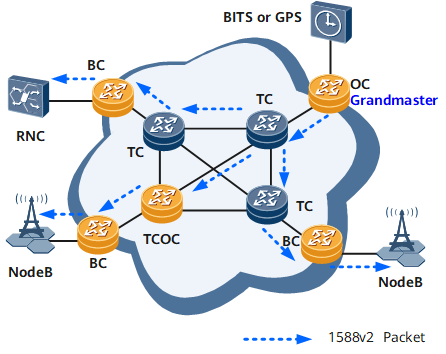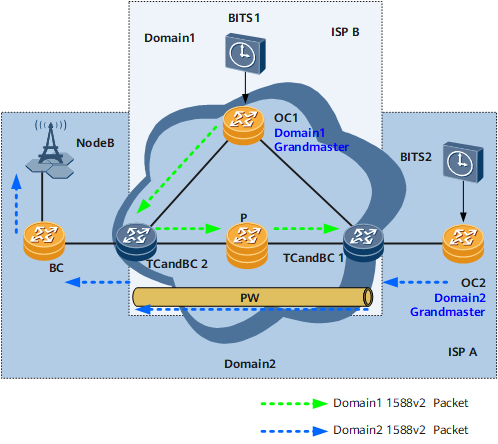Configuring Static 1588v2 Functions
This section describes how to configure static 1588v2 functions. You can specify the master and slave clocks manually, without using the BMC algorithm.
Applicable Environment
To manually determine the master/slave relationship between clock nodes within a network, run the ptp port-state command to set the status of 1588v2 interfaces on the nodes. Static clock source selection and dynamic BMC selection are two independent mechanisms. Static clock source selection has a higher priority than dynamic BMC selection.

The 1588v2 status needs to be specified on OC, BC, and TCandBC interfaces. The 1588v2 status is Premaster on TCs interfaces, including those on TCOC and TCandBC devices.
Typical static 1588v2 network with OC, BC, TC, and TCOC devices
The OC on the 1588v2 network shown in Figure 1 functions as the grandmaster to receive time signals provided by a BITS or GPS and sends 1588v2 packets carrying the time signals over the bearer network. TCs, including the TCOC, are core devices on the bearer network. TCs transparently transmit time information over the bearer network. The TCOC can also implement frequency synchronization. BCs at the edge of the bearer network send highly accurate time information carried in 1588v2 packets to wireless access devices, such as NodeBs and radio network controllers (RNCs).
Typical static 1588v2 network with TCandBC devices
All devices, including the NodeB, run 1588v2 on the network shown in Figure 2. ISP A's network contains the NodeB, OC2, and BC. OC2 is connected to BITS2 on ISP A's network. ISP A's network has no bearer network device. ISP A's network has no bearer network device. ISP A leases the bearer network that ISP B operates, and ISP B devices trace clock signals of BITS1. Time synchronization on ISP A's network is independent of that on ISP B's network. Devices on ISP A's and ISP B's networks support static 1588v2. The deployment is as follows:
- Establish domain1 for ISP B's 1588v2 network and domain2 for ISP A's 1588v2 network.
- OC1 in domain1 obtains BITS1 signals and sends 1588v2 packets carrying clock synchronization information to the BC interface that directly connects the TCandBC to OC1.
- OC2 in domain 2 is selected as the grandmaster and connected to BITS2. OC2 sends downstream 1588v2 packets carrying clock information. TC interfaces connect the TCandBC to OC2 and to the BC. The TC interfaces transparently transmit BITS2 time information to the BC. Upon receipt, the BC advertises the time information to the NodeB.
Pre-configuration Tasks
- Set physical parameters of interfaces and ensure that the interfaces are physically Up.
- The license file on the main control board has been activated by running the license active file-name command. When the clock synchronization license is not loaded, the ptp enable configuration is not allowed.
- Importing Time Signals from an External BITS Source
- On a 1588v2 network, time signals are typically imported from an external BITS source. You can configure multiple routers to import time signals from an external BITS source. A master clock can be selected dynamically or statically.
- Globally Enabling 1588v2
- 1588v2 takes effect after you configure 1588v2 in both the system and interface views. After 1588v2 is enabled in the system view, you also need to set other basic information, including the domain number and virtual clock ID, to establish a 1588v2 network.
- (Optional) Monitoring the Performance of a Passive Interface
- This section describes how to monitor the performance of a passive interface. After a 1588v2 network achieves stable time synchronization, monitor the passive interface's offset that is between the master and slave clocks.
- Enabling 1588v2 on a Specific Interface
- This section describes how to enable 1588v2 on a specific interface. 1588v2 takes effect after you configure 1588v2 in the system and interface views. You can set 1588v2 parameters in the interface view. The parameters include the link delay measurement mechanism, asymmetric delay correction, and timestamping mode.
- Specifying the 1588v2 Interface Status
- This section describes how to specify the 1588v2 interface status. After 1588v2 is enabled in the system and interface views, specify the 1588v2 status for interfaces. The master/slave clock relationships can be established based on the plan.
- (Optional) Configuring Time Attributes for 1588v2 Packets
- This section describes how to configure time attributes for 1588v2 packets. 1588v2 routers exchange Announce, Sync, and Delay or Pdelay packets to send time information and maintain 1588v2 connections. You can set the interval at which a 1588v2 interface sends Announce, Sync, and Delay or Pdelay packets and the maximum number of Announce packet timeouts. Using the default time attribute values is recommended.
- (Optional) Configuring a 1588v2 Packet Encapsulation Mode
- 1588v2 packets can be encapsulated into Layer 2 or Layer 3 packets. You can configure an encapsulation mode for 1588v2 packets based on the actual network conditions, as well as the destination addresses and transmission priority for the 1588v2 packets.
- Verifying the Configuration of Static 1588v2 Functions
- After configuring static 1588v2 functions, verify the configuration.

